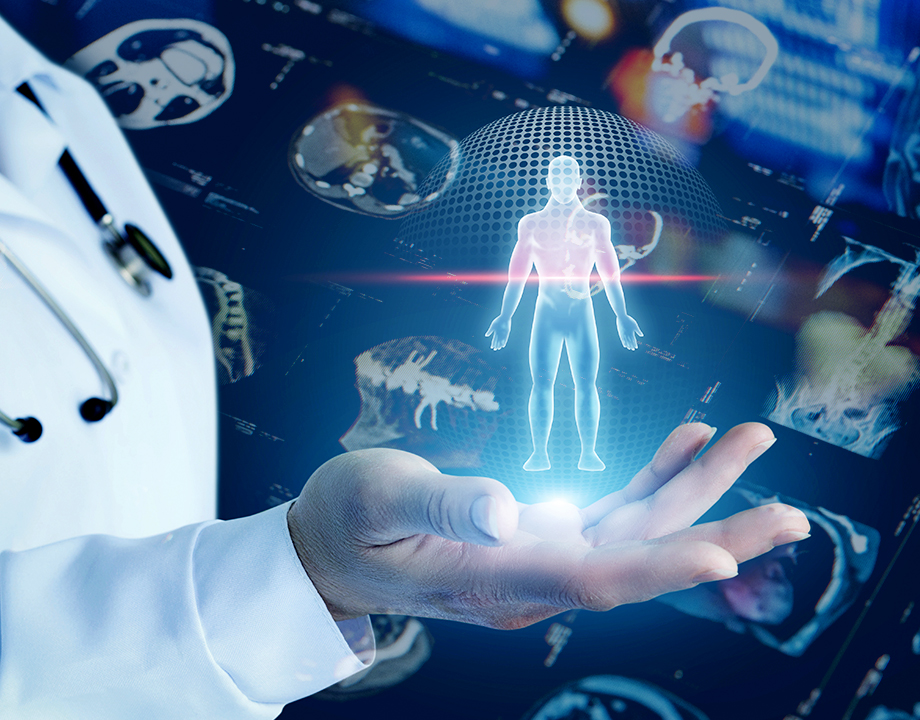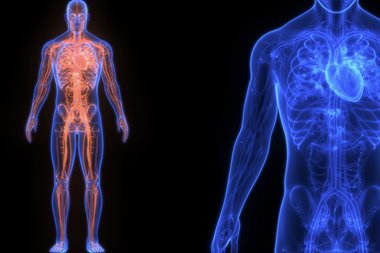A Digital Twin of a Medical Patient
A Digital Twin of a Medical Patient


A newly developed 3-D twin exactly replicates what’s going on in your body, right now, so doctors can treat the unique you.
With each trip to the doctor, you generate a digital trail of medical information that, ideally, would help doctors diagnosis and monitor your health conditions.
But, while your medical records are computerized, they’re not organized in a way that can give physicians a clear look at your unique medical history. Rather, the records that include your medical history, X-rays, and prescribed medication, sprawl across nonintegrated software systems.
But aggregating your medical information and overlaying it onto a model of a standard human body doctors could create your own personal medical model; a digital twin that shows how your real-life body is functioning in that exact moment, say researchers at the seven Fraunhofer Institutes. They recently combined forces to create exactly that: a digital twin of the human body.
The digital human will help usher in an age of personalized medicine, in which doctors will be able to tailor treatment exactly to a patient’s needs, said Stefan Wesarg, who heads the Competence Center for Visual Healthcare Technologies at the Fraunhofer Institute for Computer Graphics.
It would give doctors an overview of how your body is functioning right at that moment and how a change in medication might affect an organ like your kidney or liver, or how two medications would interact in your body, Wesarg said.
More for You: Digital Twins for the Future of Climate Change
Their MED²ICIN prototype serves as a kind of “generic” body. It combines a patient’s complete medical information with data on people with the same conditions, taken from population studies. That way, doctors can see how the same disease progressed in others and find clinical trials, and therapies of people with the same condition..
The information comes together to create a holistic digital model the patient, Wesarg said.
It’s not a mannequin-style patient that depicts internal anatomy. Rather, it’s a huge digital collection of data about how humans literally function. The information populates the 3-D models that can depict the functions of even minute systems, like a tiny capillary.
Reader’s Choice: A Digital Twin for Mother Earth
In healthcare, the virtual human twin is a safe way to test medications or make conjectures about a diagnosis. It’s a place to run “what if?” scenarios; to look, for example, at how a certain medication would affect your particular liver over time, Wesarg said.
In fact, doctors will one day be able to use the personal medical models the same way manufacturers currently call upon their own virtual twins.
In manufacturing, digital twins model the robotic line with such high fidelity that the engineer can adjust robotic movements and tweak how the machine functions virtually. After adjusting the model's profiles and operating parameters, the engineer exports the profiles and parameters to the actual control system of the physical equipment.
Editor’s Pick: 5 Ways to Cyber-Protect Your Digital Twin
This is similar to how doctors might model how medication might personally affect their patients, and look at ways to, for instance, adjust dosage to that person’s needs.
The University Hospital Frankfurt is now using the Fraunhofer twin to model chronic inflammatory bowel disease. Already their twin includes information taken from more than 600 IBD patients over 170 different parameters. The virtual patient models could cut costs and shave time from the traditionally expensive, lengthy treatment, Wesarg said.
As the technology moves forward, patients will be able to call up their virtual twins on their own devices to better understand their conditions, he added. Doctors will find myriad ways virtual twins can tailor treatment.
Personalized medicine is in its infancy, he pointed out, but it’s about to hit a growth spurt.
Jean Thilmany writes about engineering and technology in Saint Paul, Minn.
But, while your medical records are computerized, they’re not organized in a way that can give physicians a clear look at your unique medical history. Rather, the records that include your medical history, X-rays, and prescribed medication, sprawl across nonintegrated software systems.
But aggregating your medical information and overlaying it onto a model of a standard human body doctors could create your own personal medical model; a digital twin that shows how your real-life body is functioning in that exact moment, say researchers at the seven Fraunhofer Institutes. They recently combined forces to create exactly that: a digital twin of the human body.
The digital human will help usher in an age of personalized medicine, in which doctors will be able to tailor treatment exactly to a patient’s needs, said Stefan Wesarg, who heads the Competence Center for Visual Healthcare Technologies at the Fraunhofer Institute for Computer Graphics.
It would give doctors an overview of how your body is functioning right at that moment and how a change in medication might affect an organ like your kidney or liver, or how two medications would interact in your body, Wesarg said.
More for You: Digital Twins for the Future of Climate Change
Their MED²ICIN prototype serves as a kind of “generic” body. It combines a patient’s complete medical information with data on people with the same conditions, taken from population studies. That way, doctors can see how the same disease progressed in others and find clinical trials, and therapies of people with the same condition..
The information comes together to create a holistic digital model the patient, Wesarg said.
It’s not a mannequin-style patient that depicts internal anatomy. Rather, it’s a huge digital collection of data about how humans literally function. The information populates the 3-D models that can depict the functions of even minute systems, like a tiny capillary.
Reader’s Choice: A Digital Twin for Mother Earth
In healthcare, the virtual human twin is a safe way to test medications or make conjectures about a diagnosis. It’s a place to run “what if?” scenarios; to look, for example, at how a certain medication would affect your particular liver over time, Wesarg said.
In fact, doctors will one day be able to use the personal medical models the same way manufacturers currently call upon their own virtual twins.
In manufacturing, digital twins model the robotic line with such high fidelity that the engineer can adjust robotic movements and tweak how the machine functions virtually. After adjusting the model's profiles and operating parameters, the engineer exports the profiles and parameters to the actual control system of the physical equipment.
Editor’s Pick: 5 Ways to Cyber-Protect Your Digital Twin
This is similar to how doctors might model how medication might personally affect their patients, and look at ways to, for instance, adjust dosage to that person’s needs.
The University Hospital Frankfurt is now using the Fraunhofer twin to model chronic inflammatory bowel disease. Already their twin includes information taken from more than 600 IBD patients over 170 different parameters. The virtual patient models could cut costs and shave time from the traditionally expensive, lengthy treatment, Wesarg said.
As the technology moves forward, patients will be able to call up their virtual twins on their own devices to better understand their conditions, he added. Doctors will find myriad ways virtual twins can tailor treatment.
Personalized medicine is in its infancy, he pointed out, but it’s about to hit a growth spurt.
Jean Thilmany writes about engineering and technology in Saint Paul, Minn.






